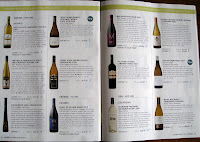First, wine drinkers don’t want to know how a wine tastes. They want to know how a wine drinks. What’s the difference?
Wine drinking is the “simple” enjoyment of a wine, either alone or with food. A wine drinker wants to know, will I enjoy the wine? Is it my kind of wine? Is it worth the price? What food, if any, would go well with it?
Wine tasting, on the other hand, is an (overly?) analytical process that deconstructs a wine into 5 elements:
- appearance (colour hue & depth, clarity)
- aroma (individual aromas, intensity, signs of age)
- taste & structure (individual flavours, intensity, dryness or sweetness, acidity, tannins)
- texture (body, mouthfeel)
- finish (length, consistency, complexity, balance)
Wine tasting is the basis for tasting notes, those blurbs that wine writers and critics compose about a particular wine. Tasting notes incorporate the taster's experience along those five elements.
But the language used can be quite esoteric, over the top in complexity and obscurity. Sommelier programs (like the one from which I graduated) spend LOTS of time teaching wine tasting as the deconstruction of a wine, but not enough time in teaching students how to put the parts back together in a way that wine drinkers will find useful.
For example, only if we’re lucky, at the end of a tasting note, will these tasters tack on an overall conclusion and perhaps suggest a food pairing. Ah, but that last little bit is the most important, the stuff that most wine drinkers want to know.
What do we get instead? Too often it’s rambling notes that try to impress us (but only frustrate us) with listings of obscure fruits, flowers, vegetables, herbs, spices, and other elements. These notes reduce a wine to its parts, when we want to know is what the wine adds up to.
(By the way, I include myself among wine tasters who are guilty of writing overly complex tasting notes. Mea culpa.)
Like so many specialties, we wine tasters have developed a special language that those of us on the inside can understand. But that same language and analytical process can get in the way of explaining to wine drinkers why they might enjoy a wine.
It’s a bit like asking someone what it’s like to drive a Ferrari, and receiving a description of the car’s components. Yes, that can be interesting to the gearhead, but what does it FEEL like to the driver?
Next post: More on what's wrong with tasting notes...
Subscribing to this blog through RSS or email is easy! Just click on the subscribe link to the left ←





No comments:
Post a Comment